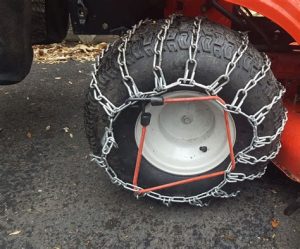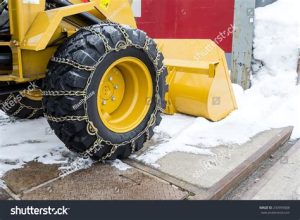Learn how to choose, prepare, and install chains on tractor tires, plus essential maintenance and safety tips for optimal performance.When winter hits and snow blankets your fields, ensuring your tractor can maneuver safely becomes essential. One of the most effective ways to enhance traction and stability is by installing chains on your tractor tires. This ultimate guide will walk you through every stage of the process, from understanding the significance of using chains to the different types available on the market. Whether you are a seasoned farmer or a novice user, knowing the proper steps to prepare your tires, install the chains, and maintain them for optimal performance is crucial. Additionally, we’ll share vital safety tips to keep you and your equipment safe while working in challenging conditions. Let’s dive into the world of tire chains and ensure your tractor is ready to tackle whatever winter throws your way!
Understanding the Importance of Chains
Chains are an essential tool for enhancing the performance of tractor tires, especially in challenging conditions. They are primarily used to provide better traction on slippery surfaces such as snow, mud, and ice. Without chains, tractors can struggle to maintain stability and grip, leading to reduced efficiency and potential accidents.
One of the main reasons to consider using tractor chains is to prevent slipping. When a tractor encounters loose soil or slick surfaces, the wheels can spin without gaining any forward momentum. Chains dig into the surface, allowing the tractor to gain traction and move effectively.
Additionally, installing chains can significantly extend the lifespan of your tires. The added grip reduces the amount of wear and tear that tires experience in adverse conditions. By investing in chains, you are also making a long-term investment in the overall health of your equipment.
Choosing the Right Type of Chains
When it comes to installing chains on tractor tires, selecting the correct type of chains is crucial for optimal performance and safety. There are various options available, each designed for specific tasks and conditions. Here, we’ll explore the factors to consider and the types of chains suitable for different applications.
1. Chain Material: It’s important to choose chains made from durable materials.
- Steel Chains: These are robust and provide excellent traction on icy or muddy surfaces.
- Alloy Chains: These chains are lightweight and resistant to corrosion, making them ideal for all-weather use.
- Rubber Chains: While not as durable as metal chains, they can be helpful for lighter loads and offer decent grip without damaging asphalt.
2. Chain Design: The design of the chains can greatly affect their functionality.
- Cleat Design: Chains with larger cleats provide better grip in snowy or muddy terrains.
- Spacing: The distance between the links impacts how well the chains conform to the tire. Tighter spacing generally results in better traction.
3. Tire Size: Ensure that the chains you choose fit the specific size of your tractor tires. Most manufacturers provide sizing charts to help match the chains with your tire dimensions. Always measure your tires before making a purchase.
Selecting the right type of chains for your tractor tires involves considering materials, design, and tire size.
Preparing the Tractor Tires for Installation
Before you begin the process of installing chains on your tractor tires, it’s essential to prepare the tires adequately. This preparation ensures that the chains fit properly and perform effectively. First, you should inspect the tractors’ tires for any signs of damage or excessive wear. Ensure that the tread is deep enough to provide the necessary traction and that there are no cracks or bulges in the rubber.
Next, clean the tires thoroughly to remove any dirt, mud, or debris that may interfere with the chain installation. Use a stiff-bristled brush and some water to achieve a clean surface. Allow the tires to dry completely before proceeding with the installation. Proper cleaning ensures that the chains can grip the tires effectively and minimizes the risk of damage during installation.
Finally, it’s also advisable to check the chain sizes and compatibility with your tractor’s tire specifications. Ensure you have the right type of chain for both the tire size and the operating conditions in which you will be using your tractor. If necessary, refer to the manufacturer’s guide or consult an expert for advice on the suitable chains for your tractor.
Step-by-Step Guide to Installing Chains
Installing chains on your tractor tires may seem like a daunting task, but with the right approach, it can be accomplished efficiently and effectively. Below is a detailed, step-by-step guide to help you through the process.
Step 1: Prepare the Area
Before you start, ensure you have a clean, flat surface to work on. This will not only make the installation easier but also safer. Clear away any debris or obstacles that might interfere with the process.
Step 2: Gather Your Tools
You will need the following tools for installation: a measuring tape, a pair of gloves, and possibly some adjustment tools for your chains. Having everything on hand will speed up the process.
Step 3: Position the Chains
Lay your chains out flat on the ground next to your tractor tire. Ensure they are not twisted or tangled. This makes it easier to identify the inner and outer side of the chains.
Step 4: Install the Chains
Start by draping the chains over the tire, ensuring they are centered. Adjust the chains to fit snugly around the tire. Make sure that the cross links are positioned properly, as this will provide the necessary traction.
Step 5: Secure the Chains
Once the chains are in place, use the provided tensioners or fastening devices. Tighten the chains carefully, ensuring they are fitted well without being overly tight, which could damage the tire.
Step 6: Check Stability
After securing the chains, rotate the tire slowly to ensure the chains are stable and are not shifting. Make further adjustments if necessary. It’s important that they fit well to provide optimal performance.
Step 7: Test Drive
Before heading out to work, take your tractor for a brief spin at a slow speed to ensure everything feels right. Listen for any unusual noises which might indicate a misalignment with the chains.
By following these \steps\, you will have successfully installed chains on your tractor tires. Proper installation not only enhances traction but also prolongs the life of your tires, ensuring you can work efficiently in various conditions.
Quick Recap:
- Prepare the area
- Gather your tools
- Position the chains
- Install the chains
- Secure the chains
- Check stability
- Test drive
Maintenance and Safety Tips for Chains
Proper maintenance of your tractor tire chains is crucial for ensuring their longevity and effectiveness. Regular inspections should be part of your routine, allowing you to identify any wear, rust, or damage that could hinder performance. A quick visual check before each use can save you from unsafe conditions on the field.
Keep your chains clean and free of debris. After use, especially in muddy or corrosive conditions, wash your chains with water and let them dry completely. This won’t just improve their traction; it also helps prevent rust and deterioration. Consider applying a light coat of lubricant to the chains to protect them from moisture and ensure smooth operation.
Safety should always be a priority when handling chains. Always wear appropriate safety gear, including gloves and eye protection, as chains can be heavy and have sharp edges. When installing or removing chains, make sure the tractor is on stable ground and turned off to prevent accidental movement. It’s also wise to familiarize yourself with the proper installation techniques to avoid personal injury or damage to the equipment.
Frequently Asked Questions
Why is it important to install chains on tractor tires?
Chains provide enhanced traction in slippery conditions, such as mud, snow, or ice, ensuring better performance and safety.
What type of chains are best for tractor tires?
The best chains depend on the specific conditions you expect to encounter, but popular choices include ladder chains, diamond chains, and V-bar chains, each offering unique benefits.
How do I determine the right size of chain for my tractor tires?
To determine the right size, you need to refer to the tire’s specifications, which usually indicate the appropriate chain size and link thickness.
What tools do I need for installing chains on tractor tires?
Common tools required include a pair of gloves, a chain tensioner, and possibly a ratchet strap for securing the chains tightly.
Can I install chains on my tractor tires by myself?
Yes, with the right tools and guidance, many people can install chains themselves; however, having an assistant can make the process easier.
What precautions should I take when installing chains on tractor tires?
Ensure the tractor is on a flat surface, wear protective gloves, and be cautious of pinching hazards while handling the chains.
How often should I check the chains after installation?
It’s advisable to check the chains after every few uses, particularly for signs of wear or loosening, to ensure optimal performance and safety.





